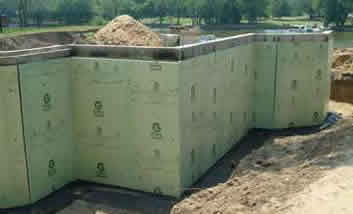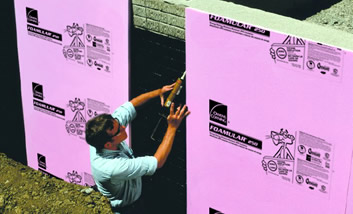Well-insulated homes are often perceived as having lots of insulation in the walls and attic while foundation insulation goes unrecognized. Un-insulated foundations can account for up to one third of the heat loss in today’s homes. Insulating a foundation can dramatically and cost-effectively reduce utility bills and improve the comfort of living areas. Foundation insulation needs to perform underground where soil pressure can crush it and wet, cold conditions can compromise insulating properties.
XPS products’ long-term thermal performance (LTTR), water resistance and crush resistance make it the ideal foundation insulation.

Slab-On-Grade
Slab-on-grade foundations are low cost options when a basement or crawl space is not possible or desirable. Slab-on-grade foundations can transmit heat into and out of the home. In addition, they are susceptible to capillary action and condensation. Insulating slab edges and under slabs saves energy and reduces moisture problems.
Frost Protected Shallow Foundations
Frost Protected Shallow Foundations (FPSF) is a construction technique which allows foundations to be built without extending below the frost line. Typically, foundation footings are required to extend below the frost line to prevent freezing temperatures below the footings so that frost heave does not damage the foundation. Section R403.3 of the 2003 International Residential Code describes a foundation that extends as little as 16” below grade anywhere in the U.S. Since FPSF require much less excavation and less concrete than typical footings, they can save thousands of dollars per home in cold climates that require deep footings.
Full Basements
Un-insulated basements can be damp, cool, musty places. Properly constructed basements, that include water management and XPS insulation, are generally warmer, dryer, more inviting living spaces. A foot of concrete has an insulating value of about R-1. That is about the same insulating value as a single pane of glass. Un-insulated basement walls can allow up to one third of the heat loss for an entire house to escape. In addition to reduced utility bills, insulated basement walls are less likely to “sweat” due to condensation. Less moisture means less potential for mold growth. Basements can be insulated with XPS on the exterior of the basement wall during construction or on the interior of the basement wall any time after construction. In most cases, building codes require XPS to be separated from occupied spaces with a fifteen minute thermal barrier, such as half-inch gypsum board. See the XPS manufacturer’s research report and the International Code Council for further details. Insulating under the basement slab can reduce condensation “sweating” of the slab. Remember, XPS is the best choice for long-term insulating performance underground due to its combination of high insulating value, second-to-none resistance to moisture absorption and crush resistance.

Crawl Spaces
Crawl spaces can be dirty, damp, and smelly. Properly constructed crawl spaces can be dry, clean and energy efficient. Crawl spaces should be constructed like a mini-basement: impermeable covering such as polyethylene on the ground and XPS insulation on the interior of the crawl space walls.
For houses built on a crawl space foundation, extruded polystyrene rigid foam can be used to complete the insulating envelope when installed on the interior face of the crawl space walls. Its’ “closed-cell” structure not only means excellent thermal performance but also gives XPS long-term resistance to water absorption – attributes which make it particularly effective in this application.
Some XPS products are recognized by building codes, allowing XPS to be left exposed on crawl space walls provided certain criteria are met. For these criteria, please see the XPS manufacturer’s research report and the International Code Council.
Termites
Foam plastic insulation can be used in “slight to moderate to heavy” termite infestation areas. See section R320.4 of the 2003 International Residential Code (IRC) for limitations in “very heavy” infestation areas.
